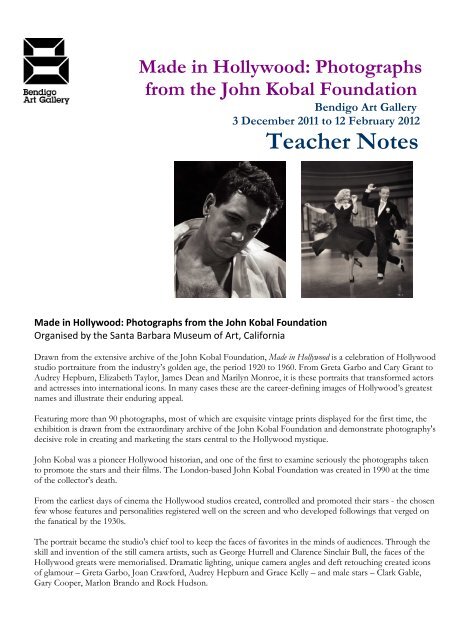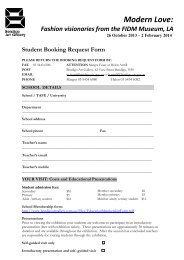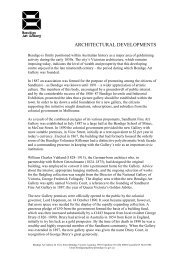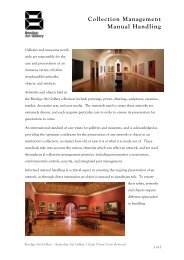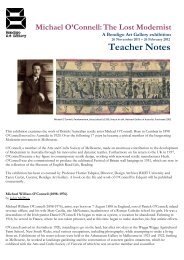Made in Hollywood: Photographs from the John Kobal Foundation
Made in Hollywood: Photographs from the John Kobal Foundation
Made in Hollywood: Photographs from the John Kobal Foundation
Create successful ePaper yourself
Turn your PDF publications into a flip-book with our unique Google optimized e-Paper software.
<strong>Made</strong> <strong>in</strong> <strong>Hollywood</strong>: <strong>Photographs</strong><strong>from</strong> <strong>the</strong> <strong>John</strong> <strong>Kobal</strong> <strong>Foundation</strong>Bendigo Art Gallery3 December 2011 to 12 February 2012Teacher Notes<strong>Made</strong> <strong>in</strong> <strong>Hollywood</strong>: <strong>Photographs</strong> <strong>from</strong> <strong>the</strong> <strong>John</strong> <strong>Kobal</strong> <strong>Foundation</strong>Organised by <strong>the</strong> Santa Barbara Museum of Art, CaliforniaDrawn <strong>from</strong> <strong>the</strong> extensive archive of <strong>the</strong> <strong>John</strong> <strong>Kobal</strong> <strong>Foundation</strong>, <strong>Made</strong> <strong>in</strong> <strong>Hollywood</strong> is a celebration of <strong>Hollywood</strong>studio portraiture <strong>from</strong> <strong>the</strong> <strong>in</strong>dustry’s golden age, <strong>the</strong> period 1920 to 1960. From Greta Garbo and Cary Grant toAudrey Hepburn, Elizabeth Taylor, James Dean and Marilyn Monroe, it is <strong>the</strong>se portraits that transformed actorsand actresses <strong>in</strong>to <strong>in</strong>ternational icons. In many cases <strong>the</strong>se are <strong>the</strong> career-def<strong>in</strong><strong>in</strong>g images of <strong>Hollywood</strong>’s greatestnames and illustrate <strong>the</strong>ir endur<strong>in</strong>g appeal.Featur<strong>in</strong>g more than 90 photographs, most of which are exquisite v<strong>in</strong>tage pr<strong>in</strong>ts displayed for <strong>the</strong> first time, <strong>the</strong>exhibition is drawn <strong>from</strong> <strong>the</strong> extraord<strong>in</strong>ary archive of <strong>the</strong> <strong>John</strong> <strong>Kobal</strong> <strong>Foundation</strong> and demonstrate photography'sdecisive role <strong>in</strong> creat<strong>in</strong>g and market<strong>in</strong>g <strong>the</strong> stars central to <strong>the</strong> <strong>Hollywood</strong> mystique.<strong>John</strong> <strong>Kobal</strong> was a pioneer <strong>Hollywood</strong> historian, and one of <strong>the</strong> first to exam<strong>in</strong>e seriously <strong>the</strong> photographs takento promote <strong>the</strong> stars and <strong>the</strong>ir films. The London-based <strong>John</strong> <strong>Kobal</strong> <strong>Foundation</strong> was created <strong>in</strong> 1990 at <strong>the</strong> timeof <strong>the</strong> collector’s death.From <strong>the</strong> earliest days of c<strong>in</strong>ema <strong>the</strong> <strong>Hollywood</strong> studios created, controlled and promoted <strong>the</strong>ir stars - <strong>the</strong> chosenfew whose features and personalities registered well on <strong>the</strong> screen and who developed follow<strong>in</strong>gs that verged on<strong>the</strong> fanatical by <strong>the</strong> 1930s.The portrait became <strong>the</strong> studio's chief tool to keep <strong>the</strong> faces of favorites <strong>in</strong> <strong>the</strong> m<strong>in</strong>ds of audiences. Through <strong>the</strong>skill and <strong>in</strong>vention of <strong>the</strong> still camera artists, such as George Hurrell and Clarence S<strong>in</strong>clair Bull, <strong>the</strong> faces of <strong>the</strong><strong>Hollywood</strong> greats were memorialised. Dramatic light<strong>in</strong>g, unique camera angles and deft retouch<strong>in</strong>g created iconsof glamour – Greta Garbo, Joan Crawford, Audrey Hepburn and Grace Kelly – and male stars – Clark Gable,Gary Cooper, Marlon Brando and Rock Hudson.
These stars would sit for portraits for each film, sometimes <strong>in</strong> costume and sometimes wear<strong>in</strong>g stylishcontemporary fashions. These portraits would be used to advertise <strong>the</strong> upcom<strong>in</strong>g film <strong>in</strong> newspapers andmagaz<strong>in</strong>es. Many of <strong>the</strong> portraits <strong>in</strong> this exhibition appeared <strong>in</strong> one of <strong>the</strong> dozens of fan magaz<strong>in</strong>es that werewidely circulated <strong>from</strong> <strong>the</strong> 1930s to <strong>the</strong> 1950s.1920sThe film <strong>in</strong>dustry's studio system was well established by <strong>the</strong> 1920s, but it was with <strong>the</strong> release of The Jazz S<strong>in</strong>gerby Warner Bros. <strong>in</strong> 1927, <strong>the</strong> first full-length film with synchronised dialogue, that <strong>the</strong> 'talkies' heralded <strong>in</strong> whatbecame known as <strong>the</strong> 'Golden Age' of <strong>Hollywood</strong>.1930sIt was dur<strong>in</strong>g <strong>the</strong> 1930s that <strong>the</strong> 'Golden Age' of <strong>Hollywood</strong> really began, and when <strong>the</strong> studio system created andcontrolled <strong>the</strong> stars now associated with <strong>the</strong> period. The <strong>in</strong>troduction of sound-mix<strong>in</strong>g resulted <strong>in</strong> advancedscripts <strong>in</strong> a wide range of genres, such as screwball comedies and gangster films, and by <strong>the</strong> end of <strong>the</strong> decade <strong>the</strong>first films were released <strong>in</strong> Technicolor, most notably Gone with <strong>the</strong> W<strong>in</strong>d (1939).1940sThe early 1940s were def<strong>in</strong>ed by World War II to which <strong>the</strong> studios responded with a realistic ra<strong>the</strong>r than escapisttone, of which Casablanca (1942) rema<strong>in</strong>s a classic. The decade is now closely associated with <strong>the</strong> 'film-noir' genrewhich began with The Maltese Falcon (1941).The <strong>Hollywood</strong> studio system reached its profitable peak dur<strong>in</strong>g <strong>the</strong> mid-1940s but <strong>the</strong> decade ended with manyof <strong>the</strong>ir practices declared illegal, and key figures were blacklisted dur<strong>in</strong>g <strong>the</strong> witch-hunt <strong>in</strong>vestigations conductedby <strong>the</strong> House of Representatives' Un-American Activities Committee.1950sThe 1950s saw <strong>the</strong> decl<strong>in</strong>e of <strong>the</strong> <strong>Hollywood</strong> studio system and <strong>the</strong> decade was remarkable for cynicalretrospection <strong>in</strong> films such as All About Eve (1950) and Sunset Boulevard (1950), and for remakes of 'Golden Age'films <strong>in</strong>clud<strong>in</strong>g <strong>the</strong> popular An Affair to Remember (1957). Technical advances, and <strong>the</strong> threat <strong>from</strong> television, led to<strong>the</strong> production of spectacular historical epics such as Ben Hur (1959) as well as colourful, escapist musicals<strong>in</strong>clud<strong>in</strong>g S<strong>in</strong>g<strong>in</strong>' <strong>in</strong> <strong>the</strong> Ra<strong>in</strong> (1952). Conversely, <strong>the</strong> decade also saw <strong>the</strong> rise of anti-heroes and hero<strong>in</strong>es and a shifttowards naturalistic 'method' act<strong>in</strong>g on screen.Images1. Rock Hudson for Lover Come Back, Universal. Leo Fuchs2. G<strong>in</strong>ger Rogers and Fred Astaire for Sw<strong>in</strong>g Time. <strong>John</strong> MiehleAll images courtesy of <strong>John</strong> <strong>Kobal</strong> <strong>Foundation</strong>, LondonOrganised by <strong>the</strong> Santa Barbara Museum of Art, CaliforniaThis exhibition is <strong>in</strong>demnified by <strong>the</strong> VictorianGovernment through Arts Victoria


